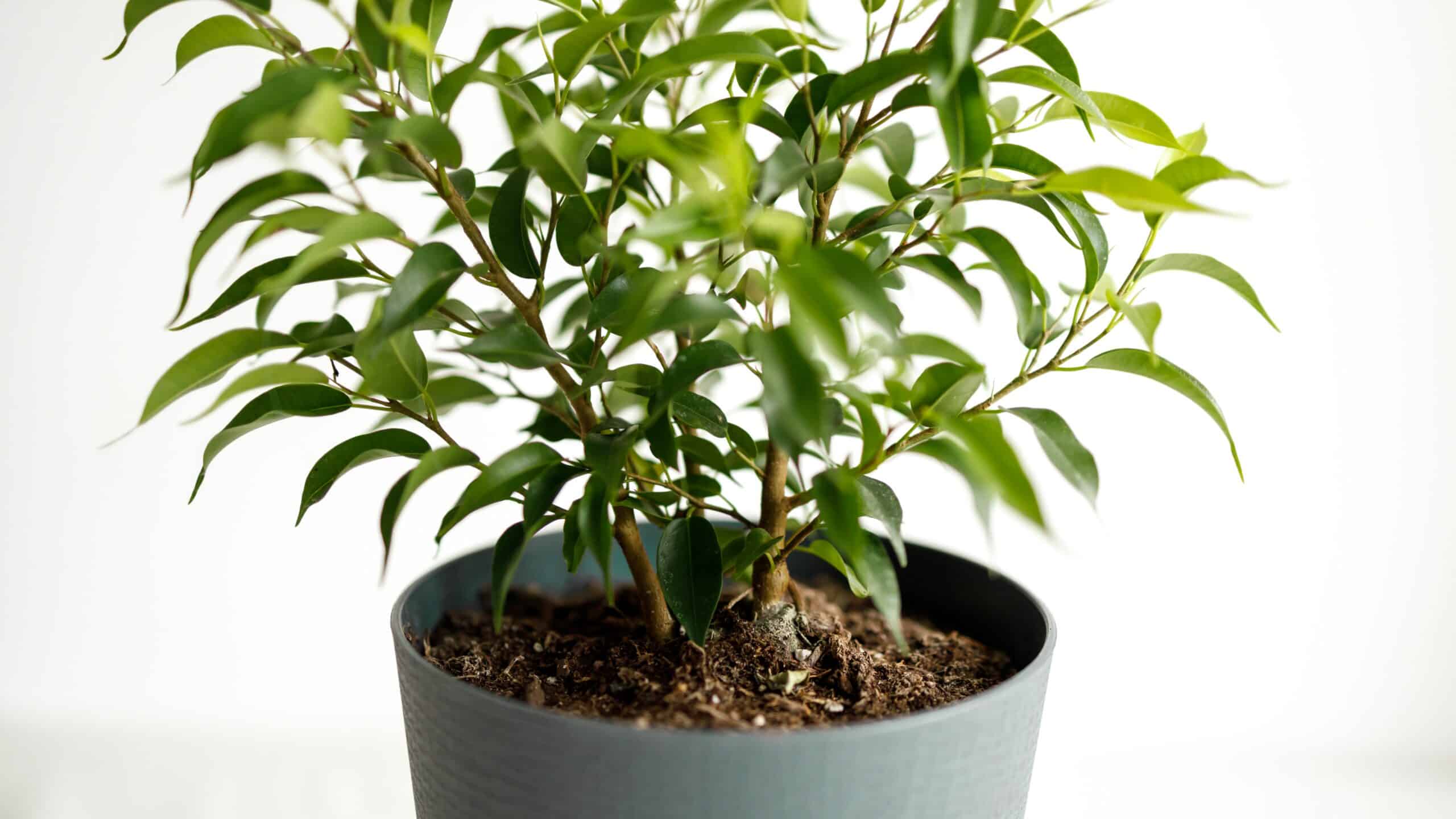Weeping Fig (Ficus Benjamina) is one of the most popular houseplants due to its lush foliage and easy-to-care-for nature. This tropical evergreen tree is native to India, Southeast Asia and Australia, bearing long, slender leaves that hang gracefully from its branches. If you are looking for a plant that is not only aesthetically pleasing but also provides environmental benefits, such as improved indoor air quality and humidity levels, then the Weeping Fig could be the perfect choice for you!
In this article we will discuss how to properly care for your Weeping Fig and ensure it grows healthy and strong indoors. From proper soil selection to watering techniques, we will provide valuable insight into growing this beautiful houseplant successfully. Additionally, we will cover tips on how to identify common problems associated with keeping a Weeping Fig in an indoor environment.
Whether you are new to gardening or have experience caring for plants, this article will provide you with the necessary knowledge to cultivate a thriving Weeping Fig indoors! So read on and discover how easy it can be to enjoy the beauty of this gorgeous plant right in your own home!
What Is A Weeping Fig?
Oh, the weeping fig! This glorious houseplant is a thing of beauty and wonder that will captivate you from the second it arrives in your home. It’s stunning foliage and unique cascading shape make it an instant centerpiece. It’s as if nature created this plant just for us – no matter where you place it, it adds character and life to any area.
The weeping fig, or Ficus Benjamina, is a popular indoor tree variety native to Southeast Asia. Its lush green leaves are oval-shaped with pointed tips that grow up to two inches long. When mature, these plants can reach heights of up to six feet tall in ideal conditions. They thrive best when grown in bright but indirect sunlight and need regular watering schedules; however, they don’t like wet feet so proper drainage is key.
But what really sets this majestic plant apart from all the rest is its ability to adapt easily to different temperatures, humidity levels, and soil types – making them one of the most versatile houseplants around! Whether you tend to forget about your plants or have a green thumb, caring for a weeping fig couldn’t be easier. So go ahead – bring this beautiful addition into your home today and watch as it instantly transforms your space!
Where To Place A Weeping Fig
It’s like inviting a guest over to your home, placing them in the perfect spot. A weeping fig is no different. It needs just the right place to feel at ease and thrive.
Finding the right spot isn’t so hard. Weeping figs prefer bright light but can also tolerate lower light conditions as long as they’re not too dark. Position it near a window that gets some sunlight, such as an east- or west-facing one, and make sure it isn’t getting direct hot sunshine, which will damage its delicate leaves. If you don’t have a window with enough light, you can supplement with fluorescent lights set about 6 inches away from the foliage for 12 hours each day.
If you want your weeping fig to be happy and healthy, provide it with an ideal environment. Place it in a location where it receives bright light without being scorched by direct sunlight, and if needed supplement with fluorescent lights for extra illumination. With these simple steps, your weeping fig will reward you with lush green foliage and plenty of graceful beauty!
Sunlight Requirements
Weeping figs, also known as Ficus benjamina, are a popular choice for indoor plants. With its evergreen leaves, it adds life and color to any room. But if you want your plant to thrive and look its best, there’s something else you need to consider—sunlight!
The amount of sunlight the weeping fig needs is not too much – in fact, it’s quite minimal. These plants prefer bright indirect light rather than direct sun, so find a spot near a window that gets good natural light but doesn’t receive direct sun for hours on end. The leaves will start to yellow or become pale if exposed to too much direct sunlight.
If you can’t provide enough light from a window, artificial lighting is an option. Use fluorescent bulbs specifically designed for growing plants; these will provide the necessary illumination without the heat or intensity of traditional incandescent bulbs. However, make sure to keep the distance between the bulb and the plant reasonable – about 8 inches should be enough.
With just enough indirect sunshine or artificial light from fluorescent lamps, your weeping fig will be happy and healthy!
Watering Needs
Watering needs for the weeping fig are fairly straight-forward. To ensure your plant stays healthy, it’s important to water it regularly. However, you don’t want to over-water it either, as this can lead to root rot and other issues.
To avoid over-watering, make sure the soil is dry before you water again. If you’re not sure, stick your finger into the soil and feel around – if it’s still damp or moist then wait a few more days until watering again. Also keep an eye on the leaves – if they start to droop or yellow then give the plant some extra hydration.
In proper balance, the weeping fig will thank you with lush green foliage and even occasional blooms! But of course, this isn’t all there is to caring for these indoor plants; temperature and humidity requirements also need attention in order to keep them happy and healthy.
Temperature And Humidity Requirements
Temperature and humidity levels are important for maintaining a healthy Weeping Fig indoors. This is especially true in colder climates or during winter months, when the air temperature and humidity may be lower than what is optimal for the plant. A case study of one Weeping Fig owner shows that an ideal temperature range for the plant is between 65-75°F (18-24°C). Moreover, the relative humidity should be kept between 40%-60%.
If these conditions cannot be maintained due to weather or environment, it is possible to artificially increase the humidity by using a humidifier. Additionally, using a hygrometer can help monitor humidity levels more accurately. Misting the leaves of your plant with water can also help raise relative humidity levels.
It is also important to place your Weeping Fig away from direct heat sources such as radiators and air conditioners that may cause sudden fluctuations in temperature and humidity levels. TIP: Place your Weeping Fig near a window where it can receive direct sunlight but avoid placing it directly in front of glass as this will increase its exposure to cold drafts.
Soil Requirements
Much like a gardener who lovingly tends to their garden, so too must one tend to the soil of the weeping fig. Like any good gardener, the soil should be prepared with care and attention. It is here that we find a powerful allegory for life’s journey – as we prepare the soil, so too should we prepare our lives for growth and success.
When it comes to soil requirements for a weeping fig, well-drained soils are best. This means that if you have heavier clay soils, you’ll want to amend them with some compost or perlite before planting your weeping fig. The ideal pH range for this plant is between 6 and 7, but it does not need to be overly precise.
Adding mulch around the base of your tree can also help keep moisture in the soil and protect its roots from temperature fluctuations. Additionally, be sure to check the drainage in your area before planting a weeping fig; if there are issues with water pooling after rainstorms or in general poor drainage, then consider raised beds or planters as an alternative way to grow a weeping fig indoors.
By following these simple guidelines when preparing the soil for your weeping fig’s home, you will ensure that it has everything it needs to grow strong and healthy – just like any great gardener would do!
Fertilizing A Weeping Fig
Fertilizing a weeping fig is an important part of keeping it healthy and happy. Providing the right nutrients to this attractive plant can be the difference between success and failure. To ensure your fig’s vibrant foliage and bountiful fruit, follow these fertilizing tips.
First and foremost, fertilize regularly. A weeping fig should be fed with a balanced fertilizer every two to three weeks during the growing season, which runs from spring until fall. To maximize results, opt for an organic fertilizer or one that uses natural ingredients such as fish emulsion or kelp meal. This will provide essential micronutrients that are often missing in synthetic products.
For best results, water your fig before applying any fertilizer to avoid burning its delicate root system. You’ll also need to adjust the amount of fertilizer you use based on whether you have a potted or outdoor fig tree; indoor plants require less than those grown outdoors in soil. Finally, keep an eye on your plant’s symptoms; if it looks yellow or pale green, it may lack essential macronutrients like nitrogen and magnesium that are found in high-quality fertilizers. With careful attention, you can ensure that your weeping fig is getting all the nutrients it needs to thrive!
Pruning And Training
Pruning and training a weeping fig is an opportunity to give your plant the care it needs to stay healthy. Like any good gardener, you must take the time to trim off dead branches and shape it in order to get the most out of your plant. Pruning is like giving a haircut – it’s not something that should be taken lightly. With careful consideration and effort, you can help your weeping fig look its best and reach its full potential.
It’s important to understand that pruning isn’t just about aesthetics; it also serves an important purpose for the health of your plant. When you prune away damaged branches and leaves, you create room for new growth which can boost vigor and improve overall health. Additionally, you can use pruning as an opportunity to train your tree into a desired shape, such as a pyramid or topiary form. This will give your weeping fig structure and add visual interest in any space.
Pruning can be intimidating at first, but with practice and patience you can become a pro in no time. Remember to always use sharp shears when cutting so that the cuts are clean; this will help minimize stress on the plant while encouraging healthier regrowth. Taking care while pruning will ensure that your tree remains healthy and strong all year round.
Common Problems
When it comes to caring for a weeping fig, common problems can occur. From pests to disease, there are several issues that can arise and require attention from the gardener. Let’s take a look at some of the potential problems that may arise with this plant:
• Pests: Common pests for this plant include spider mites, mealybugs, and scale insects. If any of these become an issue, use insecticidal soap or neem oil to treat them.
• Disease: Anthracnose and root rot are two diseases that can affect your weeping fig. To prevent these from occurring and spreading, be sure to keep up with regular pruning and prompt removal of dead leaves or stems.
• Too much light: This plant prefers bright but indirect sunlight. If it receives too much direct sunlight, the leaves may start to yellow and curl. Move the plant away from any direct light sources if this happens.
• Not enough water: Weeping figs need regular watering in order to stay healthy and happy! Remember to water whenever the top inch of soil dries out – doing so will help keep your plant looking its best!
• Over-fertilizing: Don’t over-fertilize your weeping fig! Feed it once every month during the growing season with a liquid fertilizer diluted at half strength.
These are just some of the common issues you may encounter when caring for a weeping fig – understanding them is key in keeping your plant healthy and thriving! With proper care, you’ll have an attractive centerpiece for your home or garden in no time. Now let’s move on to propagating this lovely little tree!
Propagation
If you’ve been caring for your weeping fig and want to propagate it, this section is for you. Propagating can be a great way to increase the amount of plants in your home without having to purchase new ones. While propagating is a straightforward process, there are some important notes to consider before getting started.
When propagating your weeping fig, you’ll need to take care in selecting healthy stems from the plant. Choose stems that have at least two or three leaves attached and look for any signs of damage or distress. Once you’ve chosen a stem, gently remove it from the parent plant and dip it into rooting hormone. This will help speed up the propagation process by encouraging root growth.
After applying rooting hormone, place the stem in moist potting soil and cover with plastic wrap. Place in an area with indirect sunlight and keep soil moist but not soggy over the next few weeks while waiting for roots to form. When roots appear, remove the plastic wrap and repot in fresh soil – you now have a new weeping fig!
Repotting
Repotting is a routine for the robust Weeping Fig. With proper planning and periodic pruning, this plant can be kept pristine and perfect. Practicing patience and precision in the process of repotting will help ensure that your Weeping Fig remains flourishing for years to come.
After the initial planting, it’s important to check if your Weeping Fig needs a larger pot every two to three years. Before repotting, always make sure your soil is dry so the roots can detach easily from the pot. To repot, start by removing any old soil from the roots and trimming off any dead roots using sharp scissors or shears. Next, place a layer of fresh soil in the bottom of your new pot and gently set your plant inside before filling with more soil around its roots until it’s firmly in place. Additionally, you may want to add some slow-release fertilizer to ensure good nutrition for your Weeping Fig as it grows bigger.
Finally, when you’ve finished repotting, water your plant thoroughly and place it back in its original spot – away from direct sunlight – so it can adjust over time to its new home before resuming regular watering schedule. In this way, you’ll have taken all necessary steps to keep your Weeping Fig healthy while giving it plenty of room to grow!
Varieties Of Weeping Fig
A weeping fig is like a piece of art – it’s intricate, full of life, and has its own unique story to tell. With so many varieties of this beautiful plant, it’s hard to choose just one. Each variety has its own unique characteristics that make them unique and interesting.
The most common type of weeping fig is Ficus Benjamina. This variety has thick, glossy green leaves that can grow up to 8 inches long. It also produces small white flowers in the spring and summer months. Other varieties include Ficus Lyrata which has tall upright stems with long drooping branches and leathery leaves; Ficus Microcarpa which has smaller, oval-shaped leaves; and Ficus Retusa which has a weeping shape with smaller leaves than the other varieties.
No matter what type you choose, all types of weeping figs are relatively easy to care for as long as they are provided with adequate light, humidity, and water. They can be used as an accent piece or used for bonsai purposes if you want to create a mini garden inside your home. Whatever way you decide to use them, these plants will bring beauty and life into any space!
Uses For A Weeping Fig
Is the weeping fig only a decorative piece or is there more to this plant? It has been theorized that the weeping fig can be put to use in many different ways. Let’s investigate this theory and discover just how versatile this plant can be.
Firstly, it is widely accepted that the graceful, cascading branches of the weeping fig make it an ideal choice for home decor. The soft leaves of this evergreen create a calming atmosphere, while its cascades of foliage provide texture and movement in any space.
In addition to being a beautiful ornamental piece, the weeping fig can also be used as:
- A privacy screen: With its dense foliage, the weeping fig is perfect for creating a natural barrier and providing some much needed privacy in an outdoor space.
- An air purifier: This plant can help filter out pollutants from the air and absorb carbon dioxide, making it an ideal choice for those looking to improve their indoor air quality.
The versatility of this plant does not stop there. Its low maintenance requirements make it a great option for beginners or busy people who don’t have time to spend on complex gardening tasks. Plus, its hardiness means that even if you forget to water it occasionally, it will still look good! So whether you’re looking for a decorative piece or something to help purify your air quality, the weeping fig could be just what you need.
Tips For Growing A Weeping Fig
As any experienced gardener knows, a weeping fig (ficus benjamina) can be an exquisite addition to any home or garden. But growing this magnificent species isn’t always straightforward! Here are some must-know tips for successfully cultivating a weeping fig:
Firstly, let’s travel back in time – the weeping fig needs plenty of direct sunlight to thrive. Placing near your windowsill is a great way to ensure your plant gets enough light exposure. Secondly, it’s essential to water your plant regularly – once every few days should do the trick. Additionally, make sure the soil is properly ventilated and fertilized as often as necessary. Lastly, take care not to overwater your plant – too much water can cause root rot and other issues.
Now that you know what needs to be done for optimal growth, here are five more tips on how to care for a weeping fig:
- Keep the leaves clean by wiping them with a damp cloth regularly
- Use proper pruning techniques when needed
- Pay attention to temperature control – keep it warm but not too hot!
- Put an indirect humidifier nearby if you live in drier climates
- Avoid placing potted plants in direct air conditioning or near drafts since they can easily dry out and wilt
With these tips in mind, you’ll be well on your way towards cultivating healthy, beautiful weeping figs! Now that we’ve covered the basics of growing this lovely species, let’s move on to troubleshooting any common issues that may arise…
Troubleshooting A Weeping Fig
It can be challenging to grow a healthy weeping fig plant. Take the case of Maria, who had been nursing her ficus benjamina for a few months with love and care. One day, she noticed that its leaves were drooping and turning yellow. Maria was at a loss as to what could be causing this sudden change in her beloved plant. Troubleshooting a weeping fig requires patience and perseverance in order to identify the root cause of any issues it may have.
The first step is to assess the environment where the plant is located. For example, is it getting enough sunlight? Too much sunlight? Is the soil overly dry or too wet? Are there any pests or disease present? Any of these factors can throw off the delicate balance required for a healthy weeping fig and thus should be addressed immediately.
Moreover, regular pruning and grooming are also essential maintenance activities for any weeping fig plants. Pruning helps keep an optimal shape while providing air circulation which promotes healthy growth. On top of this, regular fertilizer applications help provide necessary nutrients for sustained growth over time.
With careful observation and maintenance, you can ensure your weeping fig stays healthy and vibrant throughout its life cycle—just like Maria did with hers!
Frequently Asked Questions
How Often Should I Prune A Weeping Fig?
Weeping figs are a popular indoor houseplant, but they require extra care and attention. Pruning is an important part of keeping your weeping fig healthy and looking its best. Surprisingly, the frequency of pruning depends on the size of the tree—smaller trees need to be pruned more often than larger ones.
A good rule of thumb is to prune small weeping figs every three months or so in order to maintain their shape and size. Pruning helps promote new growth and removes dead or diseased branches. It’s also important to consider the season when it comes to pruning; many people like to prune their weeping figs in late winter or early spring as this is when they are most likely to produce new growth.
It’s also important to note that pruning should always be done with sharp, clean tools in order to prevent damage from dull blades. Additionally, make sure you remove any dead leaves or branches before you start pruning—this will help ensure that your tree remains healthy for years to come. Finally, make sure you don’t trim off too much at once as this can shock the tree and cause it stress. A little bit of careful maintenance goes a long way!
By following these simple steps, you can keep your weeping fig looking its best for years to come! With regular pruning and proper care, you can enjoy the beauty and grace that this beloved houseplant has been known for since antiquity.
What Type Of Fertilizer Should I Use For A Weeping Fig?
The lush, weeping fronds of the Ficus benjamina, commonly known as the Weeping Fig, are a sight to behold. With its cascading branches and glossy foliage, it’s an attractive addition to any indoor garden. But if you want to keep this plant looking its best, you’ll need to make sure it’s getting the right type of fertilizer.
When fertilizing your Weeping Fig, it’s important to choose one that is specifically formulated for indoor plants. This will ensure that it contains all the essential nutrients needed for healthy growth. It should also be low in salts and nitrogen so as not to burn the roots of your fragile ficus. A slow release fertilizer is ideal since it will provide a steady stream of nutrients over time and won’t have to be applied as often as other types. You can also mix in some organic matter such as compost or worm castings for even more nutrition.
To ensure your Weeping Fig stays healthy, apply fertilizer every two months during its growing season (spring through fall). Be careful not to over-fertilize – too much can lead to yellowing leaves and weak stems – and always water thoroughly before application. With proper care and feeding, your Weeping Fig will bring years of beauty into your home!
How Much Sunlight Does A Weeping Fig Need?
As if it were reaching out for a hug, the weeping fig is an evergreen tree that has gently cascading branches. Its beauty and grace make this plant a popular choice among many seeking to add a touch of nature to their home or office spaces. But before you can enjoy its pleasing presence, it’s important to understand how much sunlight your weeping fig needs in order to flourish.
Much like humans, plants need plenty of sunlight for optimal growth and health. Weeping figs need bright indirect light; too much direct sun will scorch their delicate leaves. Place your plant near a window that receives filtered sunlight throughout the day – avoid any with heavy draperies or blinds as these will reduce the amount of natural light available. Additionally, rotate your planter every few weeks so that all sides receive equal amounts of light and keep it away from any air conditioning vents which could dry out its leaves.
Weeping figs are also very resilient and can thrive in lower lighting conditions but they may not reach their full potential without adequate exposure to light. To ensure your plant stays healthy and vibrant, give it the best chance by providing it with as much natural light as possible while avoiding any drastic changes in temperature or humidity levels. In doing this, you’ll be rewarded with lush green foliage that will bring life to any room!
What Soil Type Is Best For A Weeping Fig?
When it comes to caring for a Weeping Fig, the type of soil you use is just as important as the amount of sunlight they need. The ideal soil should be well-draining and rich in organic material so that your plant can soak up all the nutrients it needs. It’s also essential to make sure that the pH balance of the soil is right, as this will affect how efficiently the roots absorb water and nutrients.
Soil that is too acidic or too alkaline won’t support healthy growth in your Weeping Fig. Luckily, there are many options available for finding soil with the correct pH balance, such as potting mixes specifically designed for houseplants or an organic mix containing sand and peat moss. If you’re unsure about what type of soil to use, consult your local nursery for advice on what would be best for your Weeping Fig’s needs.
To ensure proper drainage in your potting mix, add a layer of gravel at the bottom before adding the soil. By doing this, you’ll create good air circulation around the roots which helps avoid root rot and other issues caused by overwatering. With just a few simple steps, you can have your Weeping Fig thriving in its new home!
How Can I Tell When A Weeping Fig Needs Repotting?
As a houseplant enthusiast, you know that repotting your beloved weeping fig is essential to its health. But how can you tell when it’s time to switch its soil? Let me take you on a journey and show you the signs of when your weeping fig needs repotting.
Anachronism: Don’t let your weeping fig be a victim of the ‘out of sight, out of mind’ syndrome!
The first sign that it’s time for a new pot is root growth. If you notice roots coming out through the drainage holes in the container or if they’ve become too tightly wound around the root ball, it’s time to give your plant some room to breathe. Also, if water takes more than 10 minutes to completely drain out of the pot after watering, then it’s likely time for an upgrade.
In addition to size, pay attention to the condition of your current soil. If it looks compacted or discolored, chances are that it needs replacing with fresh soil mix. Additionally, you can check for any pests or diseases that may have developed in the existing soil and need removal.
TIP: Make sure you pick a pot with enough room for growth – at least two inches wider in diameter than its current pot – and use high-quality soil when repotting your weeping fig!
Conclusion
In conclusion, the Weeping Fig (Ficus benjamina) is an excellent choice of houseplant, and with proper care, it can provide years of enjoyment. It requires pruning regularly to maintain its shape and size, as well as fertilizing with a balanced fertilizer in the spring and summer months. It also needs plenty of indirect sunlight for optimal growth. The soil should be well-draining, preferably one that contains peat moss or perlite. Lastly, it’s important to know when your Weeping Fig needs repotting – usually when there is no longer enough room in the pot for the roots to grow.
The juxtaposition between caring for a Weeping Fig and enjoying its beauty illustrates how both aspects are equally important for a successful houseplant experience. On one hand, you need to provide proper care such as pruning, fertilizing, and repotting in order for your plant to thrive. On the other hand, having it gracefully adorn your living space makes it all worthwhile.
By taking the time to understand what this plant needs and providing those necessities with love and patience, you will be rewarded with a beautiful addition to your home – one that stands out from any other indoor plants!





























